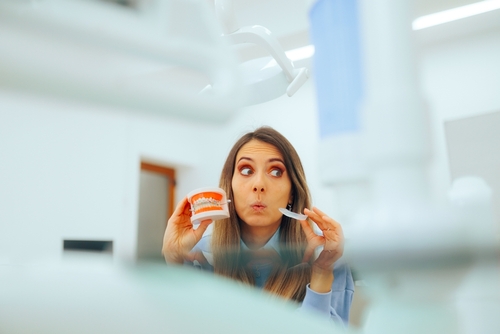
Orthodontic treatment, particularly the decision between Invisalign® and traditional braces, is a significant one for many seeking to improve their dental health and aesthetics. Both methods aim to straighten teeth, enhance oral function and provide a more appealing smile, but they do so in distinctly different ways with varied advantages and preferences.
Pros of Invisalign
-Aesthetics: One of the most compelling advantages of Invisalign is its near invisibility. The clear aligners are far less noticeable than traditional metal braces, making them a popular choice for adults and teens who are self-conscious about their appearance.
-Comfort: Invisalign trays are made from smooth plastic and are custom-fitted to the teeth, making them generally more comfortable than the brackets and wires of traditional braces which can irritate the gums and the inside of the mouth.
-Convenience: Invisalign aligners are removable. This allows for easier eating and cleaning of the teeth. Patients can brush and floss normally without the need for specialized tools. Additionally, there are no food restrictions, so patients can continue to enjoy their favorite foods.
Predictability: Using computer imaging, Invisalign offers a plan from the start to the finish. Patients can see a virtual representation of how their teeth will move during treatment, giving them a clear picture of the anticipated outcome.
Cost: Contrary to popular belief, the cost of Invisalign aligners and traditional metal braces is comparable, allowing patients to choose based on their comfort and dental requirements instead of price.
Cons of Invisalign
-Discipline: The success of Invisalign treatment relies on the patient’s commitment to wearing the aligners for 22 to 24 hours a day. Failure to wear the aligners as directed can lead to prolonged treatment or less effective results.
Pros of Traditional Braces
-Less Responsibility on Patient: Once braces are applied, they are worn 24/7 until the treatment is complete. There’s no need for the discipline required with removable aligners.
-Cost: Despite common misconceptions, the price of Invisalign and traditional braces is the same, making the choice between the two orthodontic treatments a matter of personal preference and specific dental needs rather than a financial decision.
Cons of Traditional Braces
-Aesthetics: Metal braces are more visible than Invisalign, which can be a significant drawback for many, particularly adults and teens.
-Discomfort: The brackets and wires can cause soreness in the mouth, especially after adjustments.
-Dietary Restrictions: Patients must avoid certain hard and sticky foods which can damage braces components.
-Hygiene Challenges: Braces complicate oral hygiene as food particles and plaque can become trapped in the brackets and wires. Special effort is required to keep the teeth and gums clean.
As you can see, the choice between Invisalign® and traditional braces largely depends on individual needs, lifestyle and orthodontic requirements. Both options offer efficient pathways to improved oral health and aesthetics, but they cater to different concerns and preferences. Consulting with one of our skilled orthodontists is the best way to determine the most suitable option for your specific situation.
Why Choose Us
Dr. DeArment, Dr. Lill and Dr. Song, have been designated as Diamond Plus Invisalign® providers which recognizes the top Invisalign® providers in all of North America. Whichever orthodontic option speaks to your needs, Shenandoah Valley Orthodontics welcomes you to reach out to our dedicated team to schedule a consultation!



